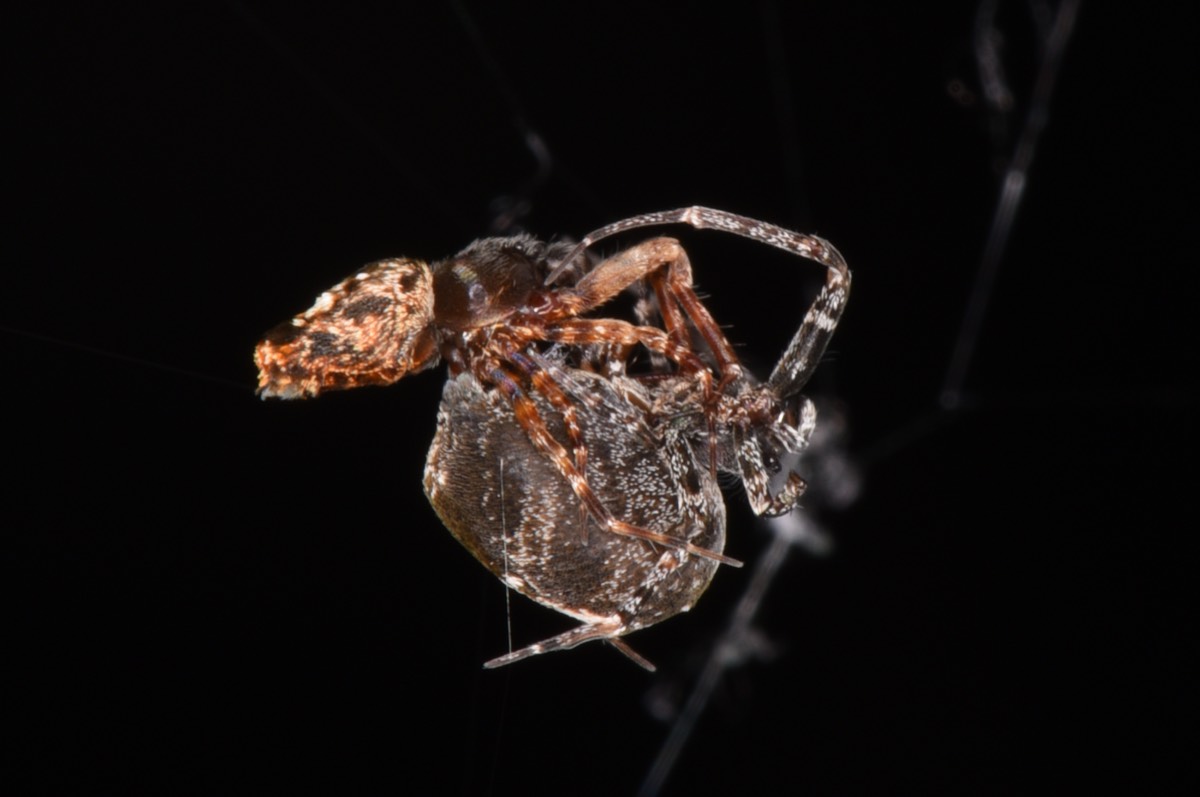Rudyard Kipling famously observed in a 1911 poem that "the female of the species is deadlier than the male." He specifically cited female bears and cobras, but the sentiment would certainly apply to many species of spider, as some female spiders habitually consume the males after mating—a behavior known as sexual cannibalism. The males in one species of orb-weaving spider (Philoponella prominens) have adopted an unusual defense strategy, according to a new paper published in the journal Current Biology. They catapult themselves away immediately after mating in hopes of having another go before being eaten—often flying through the air too quickly for a common camera to capture the details.
This species forms colonies in which spiders have individual webs that are loosely linked to form a conglomerate web complex, according to the authors. These communal webs can house as many as 215 spiders, with a male-to-female ratio of about 1.5. The team surveyed 477 such communal webs in the field, noting that the female spiders rarely left their webs and then usually only if the conglomerate web was destroyed. But the male spiders went from web to web in search of mates once they reached full maturity.
And yes, the females proved to be particularly aggressive during the mating process, which often ended in sexual cannibalism. The male spiders who escaped that fate were able to catapult away quickly once mating had concluded. Male spiders usually produced a dragline anchored to the female's web during courtship, which remained in place while mating. Once the deed was done and the female spider moved to attack, the male spider pushed himself off the web and swung to safety.
For their laboratory experiments to study the catapulting behavior, the team collected spiders—males and females just one molt away from full adulthood—from the scenery garden of Wuhan's East Lake in China. They were stored in foam-covered vials and fed yummy fruit flies twice a week as they matured.
The scientists randomly chose an unmated male and placed it into the rearing container of a randomly chosen unmated female. The female spider consumed around 20 fruit flies beforehand to ensure she wasn't hungry. They then recorded everything that happened over the next hour: courtship, palp insertion, catapulting, and whether the female spider attacked her mate and whether he survived. The team used each spider just once and then released them back into the wild (assuming they had not been eaten).

Out of 155 successful matings, the male spiders catapulted after 152 of them, ensuring their survival. The high-resolution video clocked an average peak speed of 65 cm/s, ranging from about 30 cm/s to almost 90 cm/s. The average acceleration was about 100 m/s2, and males spun around an average of 175 times per second while soaring through the air. The three non-catapulting male spiders in these trials were killed.
The authors conducted another set of trials to determine whether the male spiders' catapulting behavior was an essential component of the mating process and to confirm that this behavior served to reduce instances of the males being eaten by their mates. They placed a fine brush close to the male's dorsum to prevent the catapulting behavior. All 30 of those spiders were killed, clearly demonstrating that if a male spider wants to avoid being cannibalized by his mate, he needs to catapult.
How did the surviving spiders manage to catapult away so quickly? The team performed trials to determine whether the safety line was the cause of the catapulting behavior, both by snipping the thread while mating was in progress and by applying a thin layer of super glue to the tips of male spiders' spinnerets to block silk production. The males still managed to catapult.
Concluding that the legs were the primary mechanism, the team used a scanning electron microscope to look for any special physical structures that could trigger such ballistic jumping movements. They found that the tibia-meta-tarsus joint doesn't have an extensor muscle, so the male spiders can build up hydraulic pressure by folding the joint against the female spider. When the joint is released, it expands rapidly and launches the male into the air. However, the researchers did not find any evidence of a locking mechanism to keep the legs focused during the pressurizing stage—an aspect requiring further research.
There are a number of hypotheses about why sexual cannibalism occurs in nature. This study seems to support the "mate choice" hypothesis. “We observed that males that could not perform the catapulting were cannibalized by the female,” said co-author Shichang Zhang of Hubei University in Wuhan, China. “It suggests that this behavior evolved to fight against female’s sexual cannibalism under strong predation pressure of females. Females may use this behavior to judge the quality of a male during mating. If a male could not perform catapulting, then kill it, and if a male could perform it multiple times, then accept its sperm.”
Apparently, female spiders can mate up to five times with the same male, although it isn't clear from this study how many times a male spider would need to risk his life to successfully fertilize a female's eggs. Zhang et al. believe their study is the first to show a strong link between a male surviving sexual cannibalism and "locomotor performance."
DOI: Current Biology, 2022. 10.1016/j.cub.2022.03.051 (About DOIs).


3175x175(CURRENT).thumb.jpg.b05acc060982b36f5891ba728e6d953c.jpg)

Recommended Comments
There are no comments to display.
Join the conversation
You can post now and register later. If you have an account, sign in now to post with your account.
Note: Your post will require moderator approval before it will be visible.